中西方翻译理论汇总
- 格式:ppt
- 大小:984.50 KB
- 文档页数:27
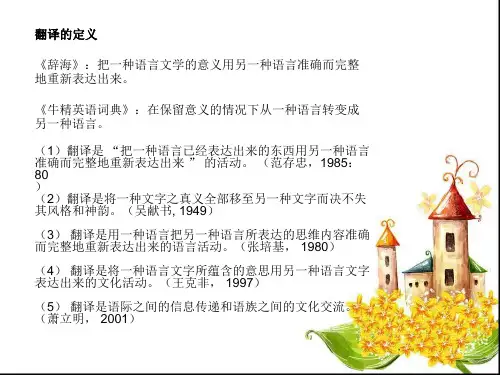
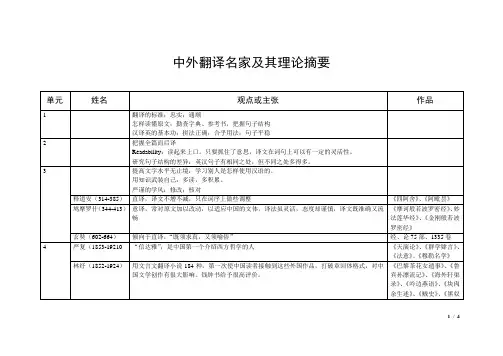
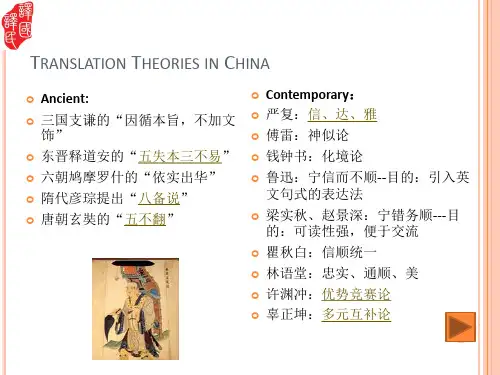
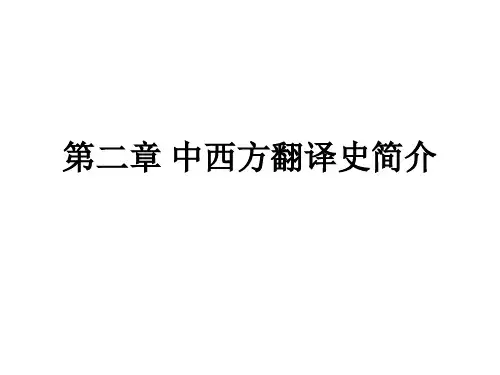
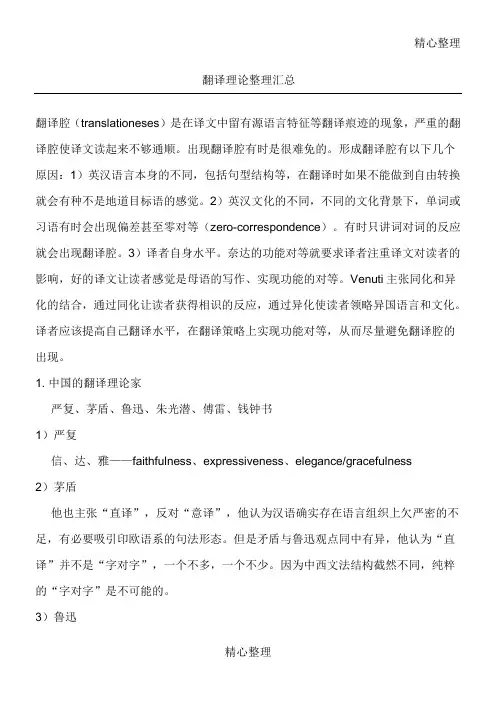
精心整理翻译理论整理汇总翻译腔(translationeses)是在译文中留有源语言特征等翻译痕迹的现象,严重的翻译腔使译文读起来不够通顺。
出现翻译腔有时是很难免的。
形成翻译腔有以下几个原因:1)英汉语言本身的不同,包括句型结构等,在翻译时如果不能做到自由转换就会有种不是地道目标语的感觉。
2)英汉文化的不同,不同的文化背景下,单词或习语有时会出现偏差甚至零对等(zero-correspondence)。
有时只讲词对词的反应就会出现翻译腔。
3)译者自身水平。
奈达的功能对等就要求译者注重译文对读者的影响,好的译文让读者感觉是母语的写作、实现功能的对等。
Venuti主张同化和异化的结合,通过同化让读者获得相识的反应,通过异化使读者领略异国语言和文化。
译者应该提高自己翻译水平,在翻译策略上实现功能对等,从而尽量避免翻译腔的出现。
1. 中国的翻译理论家严复、茅盾、鲁迅、朱光潜、傅雷、钱钟书1)严复信、达、雅——faithfulness、expressiveness、elegance/gracefulness2)茅盾他也主张“直译”,反对“意译”,他认为汉语确实存在语言组织上欠严密的不足,有必要吸引印欧语系的句法形态。
但是矛盾与鲁迅观点同中有异,他认为“直译”并不是“字对字”,一个不多,一个不少。
因为中西文法结构截然不同,纯粹的“字对字”是不可能的。
3)鲁迅鲁迅的“宁信而不顺”是“凡是翻译,必须兼顾两面,一当然是力求易解,一则保存着原作风姿”,这是鲁迅的基本思想。
针对当年那种“牛头不对马嘴”的胡译、乱译以及所谓“与其信而不顺,不如顺而不信”的说法(梁秋实),提出了“宁信而不顺”这一原则,主张直译,以照顾输入新表现法和保持原作的风貌。
他还认为,翻译一要“移情”、“益志”,译文要有“异国情调”,二要“输入新的表现法”,以改进中文的文法,在当时主要表现为改进白话文。
必须强调的是,鲁迅其实是主张翻译要通顺,又要忠实的。
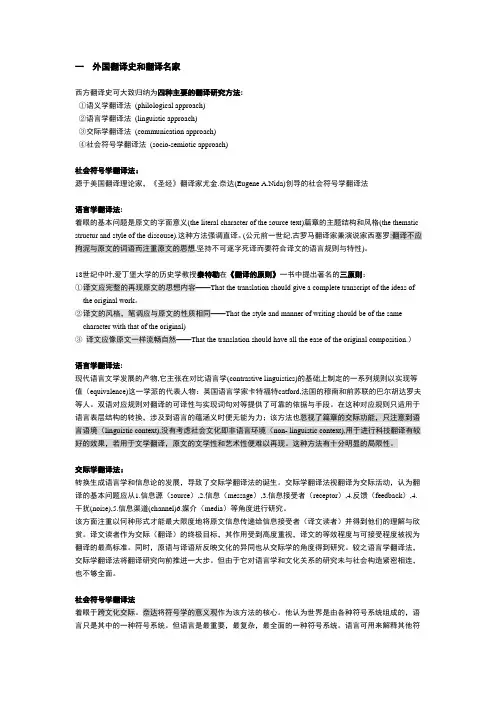
一外国翻译史和翻译名家西方翻译史可大致归纳为四种主要的翻译研究方法:①语义学翻译法(philological approach)②语言学翻译法(linguistic approach)③交际学翻译法(communication approach)④社会符号学翻译法(socio-semiotic approach)社会符号学翻译法:源于美国翻译理论家,《圣经》翻译家尤金.奈达(Eugene A.Nida)创导的社会符号学翻译法语言学翻译法:着眼的基本问题是原文的字面意义(the literal character of the source text)篇章的主题结构和风格(the thematic structur and style of the discouse).这种方法强调直译。
(公元前一世纪,古罗马翻译家兼演说家西塞罗:翻译不应拘泥与原文的词语而注重原文的思想,坚持不可逐字死译而要符合译文的语言规则与特性)。
18世纪中叶,爱丁堡大学的历史学教授泰特勒在《翻译的原则》一书中提出著名的三原则:①译文应完整的再现原文的思想内容——That the translation should give a complete transcript of the ideas ofthe original work。
②译文的风格,笔调应与原文的性质相同——That the style and manner of writing should be of the samecharacter with that of the original)③译文应像原文一样流畅自然——That the translation should have all the ease of the original composition.)语言学翻译法:现代语言文学发展的产物,它主张在对比语言学(contrastive linguistics)的基础上制定的一系列规则以实现等值(equivalence)这一学派的代表人物:英国语言学家卡特福特catford,法国的穆南和前苏联的巴尔胡达罗夫等人。

谭载喜在介绍西方翻译理论时,将西方翻译理论分为四大学派:1布拉格学派;2 伦敦派; 3 美国结构派;4 交际理论派。
而柯平在《西方翻译理论浅析》一文中介绍了六大学派:1.语言学派;2 交际学派;3 美国翻译研讨班学派;4文学-文化学派;5结构学派;6社会符号学派。
下文将一一介绍。
一、布拉格学派该学派的创始人为马希修斯(Vilem Mathesius)、特鲁贝斯科伊(Nikolay S. Trubetskoy)和雅可布森(Roman Jakobson)。
主要成员有雅可布森、列维、维内等重要的翻译理论家。
这一学派的主要论点为:(1)翻译必须考虑语言的各种功能,包括认识功能、表达功能和工具功能等;(2)翻译必须重视语言的比较,包括语义、语法、语音、语言风格以及文学体裁的比较。
布拉格学派最有影响的翻译理论家是罗曼·雅可布森。
他原籍俄国,后移居捷克;二战时迁至美国,加入美籍。
作为学派的创始人之一,他对翻译理论的贡献主要体现在《论翻译的语言学问题》(On Linguistic Aspects of Translation)之中。
文章从语言学的角度,对翻译的重要性、语言和翻译的关系以及存在的问题给出精辟的论述。
自1959年发表后,此文一直被西方理论界奉为翻译研究的经典之一。
雅可布森的论述主要有五点:(1)翻译分为三类:语内翻译(intralingual translation)、语际翻译(interlingual translation)和符际翻译(intersemiotic translation)。
所谓语内翻译,是指在同一语言内用一些语言符号去解释另一些语言符号,即通常的“改变说法”(rewording)。
所谓语际翻译,是指在两种语言之间即用一种语言的符号去解释另一种语言的符号,即严格意义上的翻译。
所谓符际翻译,是指用非语言符号系统解释语言符号,或用语言符号解释非语言符号,比如把旗语或手势变成言语表达。
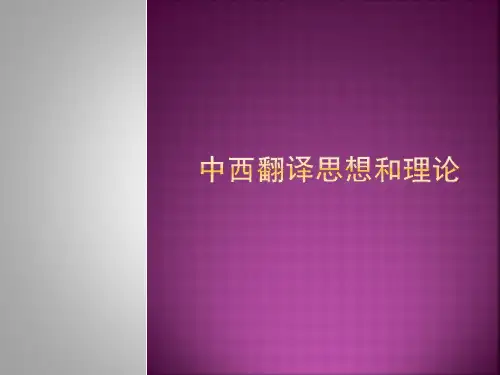


. Brief Introduction of Eugene NidaDr. Eugene A. Nida (1914--) is one of the most distinguished contemporary translation theorists in the west. During his past fifty years of study in translation theory and practice, he has achieved great success in this field. His translation theory has exerted a tremendous influence on the translation studies not only in western countries but also in Asian countries, especially in China. He is generally recognized as the most influential one among all the contemporary translation theorists.He develops the communicative translation theory put forward by Newmark, who is a famous translation theorist of England. The communicative translation theory not only emphasizes language meaning transform, but also functional equivalence. Spreading and becoming popular in China in early 1980s, Nida’s translation theory is the debut for most of Chinese translators to contact the western systematic translation theories and has deeply influenced the translation theory research in China. In spite of the doubts on his theory appearing in late 1980s and early 1990s, it is certain that Nida’s translation theory gives significant inspiration to translation researchers.With the research fruits of modern linguistics, Nida has carries out a descriptive research on translation and contemplated deeply on the major problems of the practice and research of the translation theory. With an active mind, he frequently renews the translation theory and keeps rectifying and developing his thoughts and ideas about translation theory. His translation theory is mainly on the basis of the developments of contemporary linguistics, communication theory, information theory and semiotics.2. Nida’s Functional Equivalence Theory2.1 Conception of Functional EquivalenceFunctional equivalence theory was first put forward in 1964. This principle emphasizes the functional equivalence of information instead of the direct formal equivalence in translation so as to keep the meaning and style of the source language functionally equivalent to that of the target language as much as possible. The functional feature of the translation depends on the balance of two relationships, that is, the relationship between the target language receptor and the target text should generally be equivalent to the relationship between the source language receptor and the source text, and it is the two relationships that provide the basis for functional equivalence.2.2 Literal Translation, Free Translation and Functional EquivalenceNida is the first person to handle the disputable problem between literal translation and free translation. He holds that effect is the most important element in translation. Regardless of the method of literal translation or free translation is followed, as long as the response of both source language reader and target language reader is somewhat equivalent, the best translation can be achieved.In traditional translation theory, literal translation focusing on form is called faithful, while translation emphasizing meaning is free. Nida insists translator focusing on form, especially in verses, sentences and concepts equivalence, is formal equivalence. It is dangerous in reproducing intention and meaning of original author, even worse, to result in reader’s misunderstanding. In his opinion, the translator following functional equivalence will be more faithful to the original text than following literal translation, for that the former strategy requires more fully and comprehensively understanding of the meaning of original text. Moreover.2.3 Four Levels of Functional Equivalence.Translation involves message transmission between two languages and cultures, and therestill exists lots of similarity among different language cultures, which is the objective basis. Because of the different location, history, cultural ground and education level, it is hard to be objective. The definition of translation Nida proposed shows that translation is not only related to equivalence of lexical meaning, but also the equivalence of text connotation and style, message translated in translation includes surface lexical message and deep cultural message. Functional equivalence includes four levels: lexical equivalence, sentence equivalence, passage equivalence and style equivalence.2.3.1 Lexical equivalenceThe meaning of a word lies in its usage in language. In translation practice, what confuse us is how to find the corresponding meaning in target language. Take Tension is building up as an example, tension and build up both have different explanations without consideration of context. Thus this sentence can be translated as several different editions:In English—Chinese translation, completely lexical equivalence lies in special terms and terminology, besides which there are five correspondences, word equivalence, synonymy, polysemy, lexical meaning overlap and zero equivalence.2.3.2 Sentence EquivalenceSentence equivalence is more complicated than lexical equivalence. In English- Chinese translation, singular and plural form is an important and evident problem. Plural meaning in Chinese is not expressed with any evident plural form, which is different in English. Moreover, for different target language, tender, number and tense should be taken into consideration in translation. Thus, translator should be clear about whether such a sentence grammar exists in the target language or not, and be clear about the frequency of such sentence grammar.2.3.3 Passage EquivalenceIn order to achieve passage equivalence, language is not the unique element we should consider, what we should also take into consideration is how the language represents meaning and performs its function in a specific context. Passage equivalence consists of three parts, passage context, scene context and cultural context. Passage context lies in analysis of language, which aims to judge the meaning of words and semantic units in original text, and is based on analysis of meaning and connotation of the passage. Scene context includes the concrete person and things involved in communication, the channel of communication, the relationship among participants and mental emotions.3. ConclusionNida’s translation theory has been popular in the world for nearly sixty years and it has become an indispensable part of translation studies. Holding a panoramic view of all the important points in Nida’s theory, we can conclude that the essence of his theory is that he insists the translator should pay prior attention to the meaning of the source text and should not be curbed by the expression form of the source text. Moreover, Nida’s translation theory is a genuine breakthrough and its influence and contribution to the translation field cannot be underestimated, and it dose render us a profound enlightenment that the excellent translation comes from practice.Nida has been a pioneer in the fields of translation theory and linguistics.His Ph.D. dissertation, A Synopsis of English Syntax, was the first full-scale analysis of a major language according to the "immediate-constituent" theory. His most notable contribution to translation theory is Dynamic Equivalence, also known as Functional Equivalence. For more information, see "Dynamic and formal equivalence." Nida also developed the"componential-analysis" technique, which split words into their components to help determine equivalence in translation (e.g. "bachelor" = male + unmarried). This is, perhaps, not the best example of the technique, though it is the most well-known.Nida's dynamic-equivalence theory is often held in opposition to the views of philologists who maintain that an understanding of the source text(ST) can be achieved by assessing theinter-animation of words on the page, and that meaning is self-contained within the text (i.e. much more focused on achieving semantic equivalence).This theory, along with other theories of correspondence in translating, are elaborated in his essay Principles of Correspondence,[6]where Nida begins by asserting that given that “no two languages are identical, either in the meanings given to corresponding symbols or in the ways in which symbols are arranged in phrases and sentences, it stands to reason that there can be no absolute correspondence between languages. Hence, there can be no fully exact translations.”[7] While the impact of a translation may be close to the original, there can be no identity in detail.Nida then sets forth the differences in translation, as he would account for it, within three basic factors: (1) The nature of the message: in some messages the content is of primary consideration, and in others the form must be given a higher priority. (2) The purpose of the author and of the translator: to give information on both form and content; to aim at full intelligibility of the reader so he/she may understand the full implications of the message; for imperative purposes that aim at not just understanding the translation but also at ensuring no misunderstanding of the translation. (3) The type of audience: prospective audiences differ both in decoding ability and in potential interest.Nida brings in the reminder that while there are no such things as “identical equivalents” in translating, what one must in translating seek to do is find the “closest natural equivalent”. Here he identifies two basic orientations in translating based on two different types of equivalence: Formal Equivalence (F-E) and Dynamic Equivalence (D-E).F-E focuses attention on the message itself, in both form and content. Such translations then would be concerned with such correspondences as poetry to poetry, sentence to sentence, and concept to concept. Such a formal orientation that typifies this type of structural equivalence is called a “gloss translation” in which the translator aims at reproducing as literally and meaningfully as possible the form and content of the original.The principles governing an F-E translation would then be: reproduction of grammatical units; consistency in word usage; and meanings in terms of the source context.D-E on the other hand aims at complete “naturalness” of expression. A D-E translation is directed primarily towards equivalence of response rather than equivalence of form. The relationship between the target language receptor and message should be substantially the same as that which existed between the original (source language) receptors and the message.The principles governing a D-E translation then would be: conformance of a translation to the receptor language and culture as a whole; and the translation must be in accordance with the语言学派翻译理论奥古斯丁发展了亚里士多德的“符号”理论,提出了语言符号的“能指”、“所指”和译者“判断”的三角关系,开创了西方翻译理论的语言学传统。

国内外几种翻译理论概述摘要:当今世界有许多著名的翻译家。
随着翻译文化的发展,各种翻译思想和实践逐渐在国际译学界得到了一定的重视。
在我国,翻译研究者不乏其人,例如:严复在翻译上主张的“信、达、雅”;傅雷所主张的“神似”;钱钟书的“化境论”。
与此同时,西方的翻译理论得到进一步发展。
例如:以奈达主张的“翻译必须以读者为服务的对象”的翻译思想,以及卡特福德所主张的“描写性”翻译理论。
关键词:信达雅翻译标准重神似不重形似行文流畅用字丰富色彩变化艺术修养化为我有化境理论原则翻译的性质功能语义分析程序描写性翻译转换翻译限度特征严复及“信达雅”严复是我国近代最杰出的译学理论家。
他不但提出了在中国翻译界至今还具有相当影响力的信达雅理论,他的理论及翻译"还为中国近代知识界、思想界带来了一种全然不同于过去的新的资产阶级世界观和方法论,他的译著在中国建构了一个新的资产阶级理论基础。
但是对于他的翻译的评价并不完全一致。
“信达雅”说, 是严复(1984)在《天演论译例言》中提出的:“译事三难: 信、达、雅。
求其信已大难矣, 顾信矣不达, 虽译犹不译也, 则达尚焉。
”研究严复的翻译的著述,可能已远远多于严复的译作本身了。
严复于译事的贡献涉及了理论和实践两个方面。
在翻译理论方面,严复最伟大的贡献在于,在《天演论·译例言》中,将三国时支谦《法句经序》中提到过的“信”、“达”、“雅”三字,按译事的内在规律排列组合,明确地将其作为“译事楷模”,成为“我国译界倡导系统而完整翻译标准的先驱”。
“信达雅”说“客观上起到继往开来的作用,一方面集汉唐译经论说之大成,另一方面开近世翻译学说之先河(罗新璋,1984:6)。
”“信达雅”标准的提出,把我国历史上零散的翻译观点从理论上加以扼要、中肯、鲜明、概括的综合,为后世从事翻译的人提出了明确可信、具体切实的翻译标准,使我国的翻译理论上升到一个新的阶段(高惠群、乌传衮,1992:85)。
most basic structures of Chomsky’s model,for Nida,kernels are the basic structural elements out of which language builds its elaborate(详尽复杂的) surface structures[用来构成语言复杂表层结构的基本结构成分].Kernels are the level at which the message is transferred into the receptor(受体)language before being transformed into the surface structure in three stages:Literal transfer字面转移--minimal最低度~--literary书面~2)Analysis:generative-transformational grammar(转换生成语法by Chomsky)’s four types of functional classEvent(verb)事件:行动、过程等发生的事Object(noun)实体:具体的人和物Abstract(quantities and qualities,adjective)抽象概念Relational(gender,qualities,prepositions and conjunctions)关系2,Basic factors in translation1)The nature of message:content V.S.form2)The purpose(s)of the author/translatorTypes of purposes identified by Nida:①for information②suggest a behavior③imperative(祈使,命令)purpose3)The audiences(4types):children;new literates;average literate adult;specialists3,Relatedness(相关)of language&culture4,Two basic orientations(方向)in translating1)Formal Equivalence(F-E):focuses on the message itself,in both form and content.•Principles governing F-E:①grammatical units语法单元②consistency in word usage词语用法前后一致,连贯性③meanings in terms of the source context源语语境意义2)D-E(dynamic equivalence):①based on the principle of equivalent effect(•Principles governing it)②aiming at complete naturalness of expression;③unnecessary to understand the source culture.•Economic~can be transferable with cultural~.实际上三种形式均可互相转化。
翻译理论1.西方翻译理论发轫于公元前1世纪,以古罗马帝国政治家和演说家西塞罗(Cicero,前106—43)发表的《论演说术》x标志。
2.中世纪时期从西罗马帝国崩溃起(476年)至15世纪文艺复兴止。
代表人物曼里乌?波伊提乌。
3.文艺复兴时期从14世纪末起至17世纪初止,代表人物:德西德利乌?伊拉斯谟,马丁?路德和乔治?查普曼。
4.近代时期从17世纪起直至第二次世界大战结束(黄金时代)。
代表人物:约翰?德莱顿,夏尔?巴托,亚历山大?弗雷泽?泰特勒,莱尔马赫,施雷格尔(AugustSxhlegel,1767--1815)和洪堡。
5.现当代翻译理论时期从第二次世界大战结束起至今。
“翻译范围之广,形式之多,规模之大,成果之丰,是历史上任何时期都不能比拟的”(谭载喜?《西方翻译史》1991),四大学派:a、布拉格学派: 创始人是马西休斯,特鲁贝茨考伊和雅可布逊. 代表人物有雅可布逊和吉里?列维、乔治?穆南、冉佩尔特、维内. 主要论点是:(一)考虑语言的各种功能;(二)重视语言的比较,包括语义、语法、语音、语言风格及文学体裁方面的比较。
b、伦敦派: 创始人是弗斯. 代表人物弗斯、卡特福德、萨瓦里和纽马克. 主要论点是:译文的选词是否与原文等同,必须看它是否用于相同的言语环境中.c、美国结构派;d、交际理论派。
6. 柯平在《西方翻译理论浅析》介绍有六大学派:a、语言学派:代表安德烈?费道罗夫和巴尔胡达罗夫。
b、交际学派:现于7、80年代,代表奈达和雷伯恩。
其理论渊源是信息论c、美国翻译研讨班学派:d、文学—文化学派;e、结构学派;f、社会符号学派。
7.布拉格学派:创始人是马西休斯(Vilem Mathesius,1882—1938)和两名俄国移民特鲁贝茨考伊(Nikolay S·Trubetskoy,1890--1938)和雅可布逊(Roman Jakobson, 1896--1982)。
主要代表人物有解渴的雅可布逊和吉里·列维(Jiri Levy)、法国的乔治·穆南(George Mounin)、德国的冉佩尔特(R·Jumpelt)、加拿大的维内(Jean-Paul Vinay),其中最有影响的是罗曼·雅可布逊和列维。
翻译有哪些理论翻译学中的理论有很多,以下是其中的一些主要理论:1.等效理论(Equivalence Theory):由Eugene Nida和Charles Taber于1960年提出。
该理论认为翻译的目标是在不同语言之间传达与源文本相等或相似的意义。
它强调翻译的等级和程度,分为准确传递(充分等效)、部分传递(偏远等效)和恢复信息(零等效)。
2.功能对等理论(Functional Equivalence Theory):由Christiane Nord于1991年提出。
该理论认为翻译的目标是根据目标语言和文化的读者需求,在功能上等效于源文本。
它强调翻译的目的是满足读者对论述、表述和信息的期望,并做出相应调整。
3.文化翻译理论(Cultural Translation Theory):由AndréLefevere于1992年提出。
该理论认为翻译是一种文化间的传递和变革过程,强调翻译的文化因素对于意义的建构和解读至关重要。
它探讨了源文本和目标文本之间的文化差异,并提出了译者作为文化中介者的角色。
4.再现理论(Relevance Theory):由Dan Sperber和Deirdre Wilson于1986年提出。
该理论认为翻译的目标是传递有效沟通所需的信息,并尽可能减少读者的认知努力。
它强调翻译要遵循言语交际原则,提供最相关和最明确的信息,以确保双方的理解和交流。
5.干扰理论(Interference Theory):源于歧义和误会的语言干扰现象。
干扰理论认为翻译是在源语言和目标语言之间进行的,源语言结构和表达方式会对译文产生不同程度的影响。
干扰理论研究译者如何解决干扰问题,以确保翻译的准确性和流畅性。
6.社会文化理论(Sociocultural Theory):由Lev Vygotsky于20世纪初提出。
社会文化理论认为翻译是一种社会和文化实践,翻译活动受到社会环境和文化背景的影响。
它研究翻译与社会和文化因素之间的相互关系,强调译者的角色和社会文化认知对翻译的重要性。